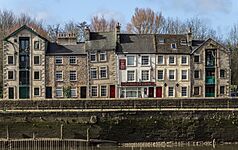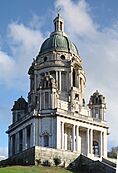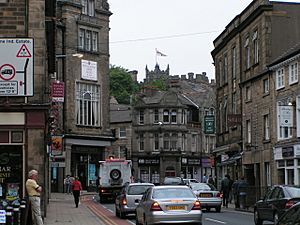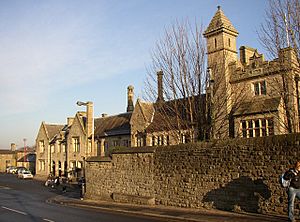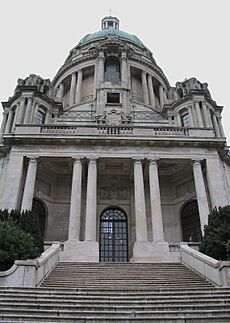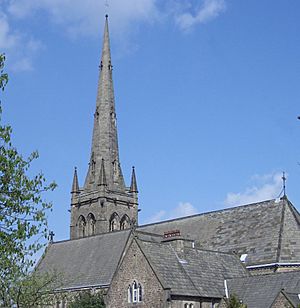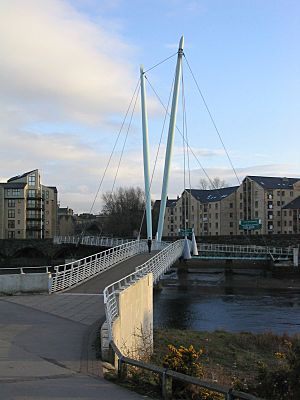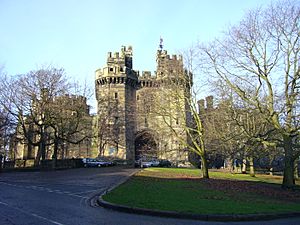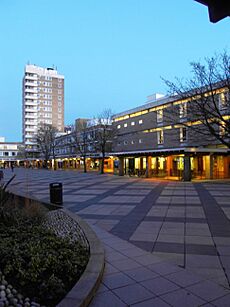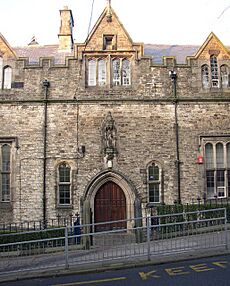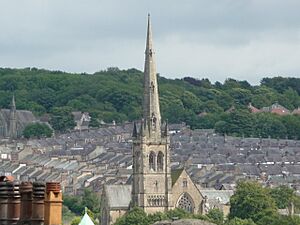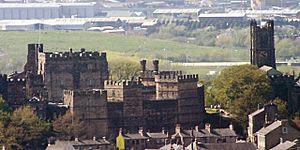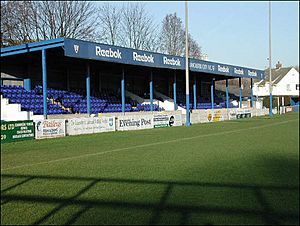Lancaster, Lancashire facts for kids
Quick facts for kids Lancaster |
|
|---|---|
|
Top: St George's Quay, on the River Lune Bottom: the Ashton Memorial (left) and Lancaster Castle (right) |
|
| Population | 52,234 |
| Demonym | Lancastrian |
| OS grid reference | SD475615 |
| District | |
| Shire county | |
| Region | |
| Country | England |
| Sovereign state | United Kingdom |
| Post town | LANCASTER |
| Postcode district | LA1, LA2 |
| Dialling code | 01524 |
| Police | Lancashire |
| Fire | Lancashire |
| Ambulance | North West |
| EU Parliament | North West England |
| UK Parliament |
|
Lancaster is a historic city in Lancashire, England. It's a main cultural and business hub for the City of Lancaster area. The city sits on the River Lune, not far from Morecambe Bay. Even though it's the county town, the main council for Lancashire is in Preston.
Lancaster has a long and interesting past, with famous landmarks like Lancaster Roman Fort, Lancaster Castle, Lancaster Priory Church, Lancaster Cathedral, and the Ashton Memorial. It's also home to Lancaster University and a campus of the University of Cumbria. In 2011, about 52,234 people lived in the city.
The House of Lancaster was a famous branch of the English royal family. Today, the Duchy of Lancaster still owns many properties for Charles III, who is also known as the Duke of Lancaster. The Port of Lancaster and its trade in the 1700s helped the city grow a lot. However, over time, the main shipping moved to Glasson Dock, which is further down the river.
Contents
History of Lancaster
Lancaster's name first appeared in a very old book called the Domesday Book in 1086. "Lon" comes from the River Lune, and "castre" means "fort" in Old English and Latin. This name tells us there was a Roman fort here long ago.
Roman and Saxon Times
A permanent Roman fort was built on the hill where Lancaster Castle now stands. It was there by the end of the 1st century AD, possibly even earlier. The fort was rebuilt with stone around 102 AD and grew to be quite large. It stayed active until the Romans left Britain in the early 5th century.
Not much is known about Lancaster between the Roman departure and the Norman Conquest in the late 1000s. However, people likely still lived there. Lancaster was on the edge of two old kingdoms, Mercia and Northumbria. Archeologists have found signs of a monastery near today's Lancaster Priory from the 700s or 800s. An old Anglo-Saxon cross found there suggests it was made in the late 800s.
Medieval Period
After the Norman conquest of England in 1066, William I took control of Lancaster. The first official document specific to Lancaster is from 1094, which talks about the founding of the Priory. By this time, William had given Lancaster to Roger de Poitou.
Lancaster became a borough (a town with special rights) in 1193, thanks to King Richard I. Its first official paper, called a charter, was from John, who later became King of England.
Lancaster Castle, partly built in the 1200s and made bigger by Elizabeth I, stands where the Roman fort used to be. It's famous for the Pendle witch trials in 1612. The court at the castle sentenced many people, earning Lancaster the nickname "the Hanging Town." The city also faced challenges during religious changes, with a memorial to the Lancaster Martyrs near the city centre.
The House of Lancaster had a red rose as its symbol, while the House of York had a white rose. These symbols came from the royal families in the 1400s. Their rivalry led to a civil war called the Wars of the Roses.
Today, the term "Wars of the Roses" is used for sports rivalries between teams from Lancashire and Yorkshire. It's also used for the Roses Tournament, where Lancaster and York universities compete every year.
Lancaster became a market town and borough in 1193. But it didn't become a city until 1937. Many buildings in the city centre and along St. George's Quay are from the 1800s. This was when the port was very busy and played a big part in the UK's trade, including the slave trade. However, the River Lune started to get too shallow, so Lancaster's time as a major port didn't last long. Nearby places like Morecambe, Glasson Dock, and Sunderland Point became the main ports for a while. Now, Heysham is the main port for the area.
Recent History
Today, Lancaster is mostly a city that provides services. It used to make things like textiles, chemicals, and paper. In recent years, new technology companies have moved to the city.
A military base, Bowerham Barracks, was built in the town in 1880. In March 2004, Lancaster was named a Fairtrade City, meaning it supports fair trade practices.
The European headquarters of Reebok used to be in Lancaster. After Reebok joined with Adidas, they moved in 2007. In May 2015, Queen Elizabeth II visited Lancaster Castle, her first visit in over ten years.
How Lancaster is Governed
The city of Lancaster is part of the City of Lancaster district within Lancashire. The Lancaster City Council manages the district. Lancaster itself doesn't have a separate local council. It's divided into areas called wards for elections, like Bulk, Castle, and John O'Gaunt (named after a famous duke).
For elections to the larger Lancashire County Council, Lancaster is divided into different electoral areas.
Geography of Lancaster
Lancaster is the most northern city in Lancashire. It's about three miles inland from Morecambe Bay. The city is built along the River Lune, which is where its name comes from, and the Lancaster Canal.
 |
Morecambe Bay, Barrow-in-Furness | Slyne, Hest Bank, Bolton-le-Sands, Carnforth, Milnthorpe, Kendal | Caton, Halton, Kirkby Lonsdale, Wennington |  |
| Morecambe, Heysham | Quernmore | |||
| Glasson Dock, Pilling, Knott End-on-Sea, Fleetwood, Poulton-le-Fylde, Blackpool | Lancaster University, Galgate, Bay Horse, Garstang, Preston | Abbeystead, Forest of Bowland, Dolphinholme |
Transport in Lancaster
Roads
The A6 road, an old main road that runs north to south in England, goes through the city centre. It crosses the River Lune on two different bridges. This road connects Lancaster to places like Preston in the south and Kendal in the north.
The M6 motorway runs to the east of Lancaster, with exits at junctions 33 and 34. The Bay Gateway, a new dual carriageway opened in 2016, connects Heysham to the M6.
Stagecoach Cumbria & North Lancashire is Lancaster's main bus company. They run services all over the Lancaster area and to further places like Kendal and Blackpool. There are frequent buses to Lancaster University.
Trains
Lancaster has a train station on the West Coast Main Line. You can catch trains to major cities like London, Glasgow, Edinburgh, and Manchester. There's also a local service to Morecambe. The station used to be called Lancaster Castle to tell it apart from another station, Lancaster Green Ayre, which closed in 1966.
Water and Air Travel
The Port of Lancaster became important in the 1700s. However, today, most ships use Glasson Dock. Heysham Port, about 5 miles west of Lancaster, has ferry services to the Isle of Man and Ireland.
The Lancaster Canal and River Lune both run through the city.
The closest airports are Manchester and Liverpool.
Cycling
In 2005, Lancaster was chosen as one of six English towns to encourage cycling. The city has many cycle routes, including paths on old railways and canal towpaths.
Famous Landmarks
Lancaster has many famous places to visit:
- Ashton Memorial
- The Dukes (a theatre)
- Custom House (now the Maritime Museum)
- Grand Theatre
- Judges' Lodgings
- Lancaster Castle
- Lancaster Cathedral
- Lancaster City Museum
- Lancaster Priory
- Lancaster Royal Grammar School
- Lancaster Town Hall
- Lune Millennium Bridge
- Queen Victoria Memorial
- Williamson Park
The city's main war memorial is in a garden next to the Town Hall. It remembers those who died in the World Wars and other conflicts.
Historic Buildings
Lancaster has over 330 listed buildings, which are buildings with special historical or architectural importance. Four of these are Grade I listed, the highest level. These include the Ashton Memorial, the Judges' Lodgings, Lancaster Castle, and Lancaster Priory.
Culture in Lancaster

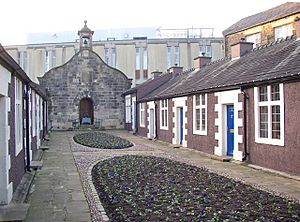
Lancaster has many historic buildings and places for entertainment. It has kept many beautiful examples of Georgian architecture. Lancaster Castle, the Priory Church of St Mary, and the Ashton Memorial are very important historical sites. The city also has several museums, like the Lancaster City Museum and the Maritime Museum.
The Lancaster Friends Meeting House, built in 1708, is the longest continually used Quaker meeting place in the world. George Fox, who started Quakerism, was imprisoned in Lancaster Castle in the 1660s. The meeting house hosts Quaker meetings and many cultural activities. The Lancaster Grand Theatre is another old cultural venue, built in 1782, and has been a big part of the city's social life.
Lancaster is well-known for its arts scene. Many businesses and groups in the area are involved in arts and culture. In 2009, several major arts groups formed "Lancaster Arts Partners" (LAP) to help develop arts in the district. They organize "Lancaster First Fridays," a monthly mini-festival.
Lancaster University has its own public arts organization called "Lancaster Arts at Lancaster University." It includes the Nuffield Theatre, one of the largest professional studio theatres in Europe, and the Peter Scott Gallery, which has a big collection of Royal Lancastrian ceramics.
The gallery in the Storey Creative Industries Centre is now run by Lancaster City Council. Williamson Park hosts outdoor performances in the summer, including a popular "Play in the Park" by the Dukes theatre group.
Lancaster is known as the Northern City of Ale, with almost 30 pubs serving special beers. There are also two local breweries.
The Lancaster Grand Theatre and the Dukes are popular places for live shows. Throughout the year, events like the Lancaster Music Festival and Lancaster Jazz Festival take place. Every November, the city hosts "Light Up Lancaster," a festival of light and art that includes fireworks.
Lancaster still has two cinemas in the city centre: Vue and the Dukes Playhouse.
Music in Lancaster
The city's professional Haffner Orchestra is known for classical music. They perform at the Ashton Hall and Lancaster University.
During parades, you might see the Lancaster City Brass band, which is very old, and Batala, a samba drumming group.
Many successful bands and musicians have come from Lancaster since the 1990s. These include John Waite, who had a number one hit song called "Missing You," and members of bands like Lush and Hard-Fi.
Since 2006, Lancaster Library has hosted music events called "Get it Loud in Libraries." Famous artists like Ellie Goulding and Adele have performed there.
Popular music venues include The Dukes, The Grand Theatre, and The Gregson Centre.
Festivals
The Lancaster Jazz Festival is in September, and the Lancaster Music Festival is in October. They both feature performances all over the city.
The Highest Point Festival happens in Williamson Park every summer.
Media in Lancaster
Local radio stations include Heart North Lancashire & Cumbria and Beyond Radio. BBC Radio Lancashire also covers the area.
Lancaster University has its own student radio station, Bailrigg FM, and an online student TV station called LA1TV.
Local TV news is provided by BBC North West Tonight and ITV Granada Reports.
Local newspapers include The Lancaster Guardian and The Visitor. Virtual Lancaster is a website with local news and events.
Twin Cities
Lancaster is connected with these cities around the world:
Education in Lancaster
Universities
Lancaster University is located south of the city. It's a research university founded in 1964. It has many staff and students. Its business school is very highly rated, and its physics department was ranked number one in the UK in 2008. In recent years, it has been ranked among the top universities in the UK and worldwide. It also has campuses in other countries.
Lancaster also has a campus of the University of Cumbria, which started in 2007. It offers courses in arts, social sciences, business, teaching, and healthcare.
Other Schools
- Lancaster and Morecambe College offers further education.
Secondary Schools
- Lancaster Royal Grammar School and Lancaster Girls' Grammar School are selective schools. They were ranked among the top UK schools in 2016.
- Ripley St Thomas Church of England Academy
- Our Lady's Catholic College
- Central Lancaster High School
- Jamea Al Kauthar Islamic College is an independent girls' school.
Primary Schools
- Lancaster Steiner School
- Scotforth St Pauls CofE Primary School
- Moorside Primary School
- St Bernadette's Catholic Primary School
- Bowerham Primary School
- The Cathedral Catholic Primary School
- Dallas Road Community Primary School
- Willow Lane Community Primary School
- Castle View Community Primary School
- Lancaster Christ Church CofE Primary School
- St Joseph's Catholic Primary School
- Skerton St Lukes CofE Primary School
- Lancaster Ryelands Primary School
Special Educational Needs (SEN) Schools
- The Loyne
- Morecambe Road School
Places of Worship
Lancaster has many churches and other places for worship. Lancaster Cathedral (Catholic) is a beautiful building with a spire that can be seen across the city. It was built in the 1700s and rebuilt in the 1800s.
Lancaster Priory (Anglican) is a very old church next to Lancaster Castle. It dates mostly from the 1430s.
The Friends Meeting House, near the train station, was built in 1708.
Other notable churches in the city include:
- Active Churches:
- Christ Church
- Ripley School Chapel
- St Thomas' Church
- St Paul's Church, Scotforth
- St Luke's Church, Skerton
- Churches no longer used:
- Lancaster Cemetery Chapels
- St John the Evangelist's Church (now managed by a conservation trust)
- Converted Churches:
- St Michael's Chapel, Lancaster Moor Hospital (now flats)
Lancaster also has places of worship for Baptists, Jehovah's Witnesses, Latter Day Saints, and Methodists, as well as the Salvation Army. There are also several mosques in the city, including Moorlands Islamic Centre and Raza Mosque Lancaster.
Sports in Lancaster
Lancaster City F.C. is the local football team. They play their home games at the Giant Axe ground. The club was formed in 1911.
Lancaster John O' Gaunt Rowing Club is one of the oldest rowing clubs in the UK. They compete in national races.
Lancaster is one of the cities that hosts the International Youth Games. This is a multi-sport event like the Olympics, with young athletes from Lancaster's twin towns.
Lancaster Cricket Club is located near the River Lune. Rugby union is also popular, with local clubs like Vale of Lune RUFC.
The city has several golf courses, including Lancaster Golf Club. The Lancaster Amateur Swimming and Waterpolo Club trains at Salt Ayre and Lancaster University.
The local athletics track is home to Lancaster AC and Morecambe AC. Athletes compete in various sports like track and field, cross country, and running.
Notable People from Lancaster
Arts and Entertainment
- Joe Abercrombie (born 1974) – fantasy writer.
- Cherith Baldry (born 1947) – children's writer.
- Jim Bowen (1937–2018) – comedian.
- Laurence Binyon (1869–1943) – poet.
- Jon Richardson (born 1982) – comedian.
- John Waite (born 1952) – rock musician, famous for "Missing You."
- Frankie Vaughan (1928–1999) – singer and actor.
Business Leaders
- Henry Cort (c. 1741–1800) – inventor in the iron industry.
- Robert Gillow (1704–1772) – founder of a famous furniture company.
- James Williamson (1842–1930) – businessman who created Williamson Park and Ashton Memorial.
Science and Learning
- J. L. Austin (1911–1960) – philosopher.
- John Ambrose Fleming (1849–1945) – electrical engineer and physicist.
- Edward Frankland (1825–1899) – chemist who came up with the idea of valence.
- Richard Owen (1804–1892) – biologist who created the word "dinosaur."
- Emily Williamson (1855–1936) – co-founder of the RSPB (Royal Society for the Protection of Birds).
- Gavin Wood (born 1980) – co-founded Ethereum, a major blockchain platform.
Sports Stars
- James Beattie (born 1978) – professional footballer.
- Scott Durant (born 1988) – Olympic gold medal-winning rower.
- Scott McTominay (born 1996) – professional footballer.
- Jason Queally (born 1970) – Olympic gold medal-winning cyclist.
- Alan Warriner-Little (born 1962) – champion darts player.
Images for kids
See also
 In Spanish: Lancaster (Lancashire) para niños
In Spanish: Lancaster (Lancashire) para niños


